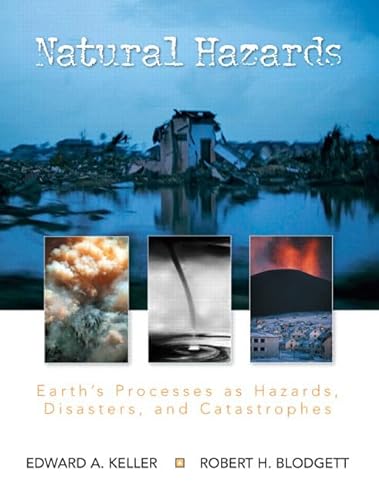
Synopsis
Natural Hazards focuses on hazards as the interface between humanity and its needs for space and resources and the ongoing geologic processes of Earth. For an introductory course in geologic hazards for non-science majors. Together with easy-to-assign projects of Hazard City: Assignments in Applied Geology, the Prentice Hall Geoscience Animations Library, and the Prentice Hall’s Environmental Geology Video Series, Natural Hazards provides the most comprehensive instructor and student learning package available.
"synopsis" may belong to another edition of this title.
About the Author
Edward A. Keller
Ed Keller is a professor, researcher, writer, and most importantly, mentor and teacher to undergraduate and graduate students. Currently, Dr. keller's students are working on earthquake hazards, how waves of sediment move through a river system following disturbance, and geologic controld on habitat to endangered southern steelhead trout. He was born and raised in California (Bachelor’s degree in Geology and Mathematics from California State University at Fresno, Master’s degree in Geology from University of California at Davis), it was while pursuing his Ph.D. in Geology from Purdue University in 1973 that Ed wrote the first edition of Environmental Geology, the text that became the foundation of the environmental geology curriculum. Ed joined the faculty of the University of California Santa Barbara in 1976 and has been there since, serving multiple times as the chair of both the Environmental Studies and Hydrologic Science programs. In that time he has been the author on over 100 articles, including seminal works on fluvial processes and tectonic geomorphology. Ed’s academic honors include the Don J. Easterbrook Distinguished Scientist Award, Geological Society of America (2004), Quatercentenary Fellowship from Cambridge University, England (2000), two Outstanding Alumnus Awards from Purdue University (1994, 1996), A Distinguished Alumnus Award from California State University at Fresno (1998), the Outstanding Outreach Award from Southern California Earthquake Center (1999).
Ed and his wife Valery, who brings clarity to his writing, love walks on the beach at sunset and when the night herons guard moonlight sand at Arrroyo Burro Beach in Santa Barbara.
Robert H. Blodgett
Bob Blodgett is Professor of Geology at Austin Community College in Austin, Texas, where he teaches natural hazards and disasters, environmental, physical, and historical geology, as well as environmental science, and manages the college’s Edwards Aquifer monitoring well and is physical sciences safety coordinator. Bob has nearly 25 years of teaching experience, including positions on the faculties of Ohio State University and Dickinson College.
He is a Licensed Professional Geoscientist and worked for six years in the state of Texas Public Drinking Water Program leading a team of scientists evaluating the vulnerability of drinking water to contamination, and for two years at the Texas Bureau of Economic Geology conducting environmental assessments of abandoned mined lands. His research on terrestrial sedimentary processes resulted in published papers on braided streams, ancient soils, and fossil burrows.
Bob has practical experience planning for and responding to natural hazards. While in the Air Force he served as the disaster preparedness officer for the remote Indian Mountain Air Force Station in Alaska, and for the underground Cheyenne Mountain Command post of the North American Aerospace Defense Command in Colorado Springs.
He traces his interest in natural hazards back to Alma Petrini, his second grade teacher in Detroit, whose lesson on volcanoes and earthquakes came alive with stories and pictures of her trips to Paricutin and Pompeii, and to lava samples that Gordon Macdonald, then director of the Hawaiian Volcano Observatory, sent him for his class project. These experiences led to a life-long interest in geology including three degrees, a B.S. from the University of Wisconsin at Madison, an M.S. from the University of Nebraska at Lincoln, and a Ph.D. from the University of Texas at Austin.
Bob and his partner Jeff, who helps him focus on the important things in life, enjoy traveling, exploring new restaurants, and making a home with their dog Mona.
Synopsis
Natural Hazards focuses on hazards as the interface between humanity and its needs for space and resources and the ongoing geologic processes of Earth. For an introductory course in geologic hazards for non-science majors. Together with easy-to-assign projects of Hazard City: Assignments in Applied Geology, the Prentice Hall Geoscience Animations Library, and the Prentice Hall's Environmental Geology Video Series, Natural Hazards provides the most comprehensive instructor and student learning package available.
"About this title" may belong to another edition of this title.
Other Popular Editions of the Same Title
Search results for Natural Hazards: Earth's Processes as Hazards,...
Natural Hazards: Earth's Processes as Hazards, Disasters, and Catastrophes
Seller: World of Books (was SecondSale), Montgomery, IL, U.S.A.
Condition: Good. Item in good condition. Textbooks may not include supplemental items i.e. CDs, access codes etc. Seller Inventory # 00053854392
Natural Hazards: Earth's Processes as Hazards, Disasters, and Catastrophes
Seller: HPB-Red, Dallas, TX, U.S.A.
paperback. Condition: Good. Connecting readers with great books since 1972! Used textbooks may not include companion materials such as access codes, etc. May have some wear or writing/highlighting. We ship orders daily and Customer Service is our top priority! Seller Inventory # S_362878295
Natural Hazards: Earth's Processes as Hazards, Disasters, and Catastrophes
Seller: ThriftBooks-Dallas, Dallas, TX, U.S.A.
Paperback. Condition: Very Good. No Jacket. May have limited writing in cover pages. Pages are unmarked. ~ ThriftBooks: Read More, Spend Less. Seller Inventory # G0130309575I4N00
Natural Hazards: Earth's Processes as Hazards, Disasters, and Catastrophes
Seller: ThriftBooks-Atlanta, AUSTELL, GA, U.S.A.
Paperback. Condition: Good. No Jacket. Pages can have notes/highlighting. Spine may show signs of wear. ~ ThriftBooks: Read More, Spend Less. Seller Inventory # G0130309575I3N00

